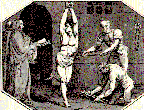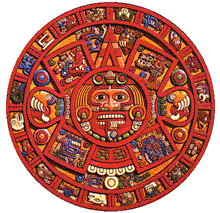 |
On Peasants and Pagans
•See bottom of page for suggested readings• |
 |
Chapter 1: The Destruction of Medieval Society in Europe
In Medieval and Renaissance Europe, in the times preceding the extensive persecutions
of pagans and Jews during the inquisitions conducted by the Churches, there was a
religious dichotomy which corresponded to the class divisions of the population into
aristocrats and peasants. Aristocrats, though their wealth was in medieval times
entirely derived from local resources and labor, were connected to a centralized
religious and political power structure which was Christian, and rigidly so. Peasants,
on the other hand, interacted with any social structure beyond their immediate vicinity
only through the local aristocrats and local clergy. Their relationships were with the
local environment, which included not only the agricultural milieu in which they labored
but a still extensive wilderness as well. The peasants retained much of the pagan
practices of their ancestors, including not only herbalism and spellcasting, but also
the development of great expertise, influence and even power by certain individuals who
were not only healers but repositories of ancient knowledge and active on behalf of the
local people in their relationships with the natural environment as well as with the
social structure which often threatened their security and livelihood.
 Then as now, the holders of centralized power saw the local environment as potential
resources to be utilized in a context which was wide-ranging and based on the drive
for wealth on the part of those in power, not on the subsistence needs of local people.
Their decisions regarding how to utilize those resources, which include the local people
themselves, who were and are the source of most of the labor required, were based on
the potential gain to be derived, not on such factors as the maintenance of the health
of the local environment, the social and cultural health of the local people, or the will
of those same people.
Then as now, the holders of centralized power saw the local environment as potential
resources to be utilized in a context which was wide-ranging and based on the drive
for wealth on the part of those in power, not on the subsistence needs of local people.
Their decisions regarding how to utilize those resources, which include the local people
themselves, who were and are the source of most of the labor required, were based on
the potential gain to be derived, not on such factors as the maintenance of the health
of the local environment, the social and cultural health of the local people, or the will
of those same people.
In the popular mind there exists much prejudice against the medieval period. Images of
powerless serfs in sweaty rags laboring for capriciously vicious and greedy overlords abound.
Yet, it is interesting to notice that the conditions in the cities of the mercantile and
industrial periods were arguably worse than in the rural medieval world, and that the
persecution of the local, which is to say, pagan, religion was at its height not in the
medieval period but after it had ended.
As the Europeans explored, "discovered" and conquered much of the rest of the world, the
locally oriented and integrated society of feudalism gave to way to an even more centralized
system of power and economics. Royal chartered companies garnered profits from far-flung
enterprises, goods and wealth flowed in immensely greater quantites than previously, and
many rural folk found themselves displaced from their agrarian life and forced into the
growing cities.
In order to change from a rural economy based on the maintenance of a local feudal power
structure to one more intricately integrated with the national and global economy, it was
necessary to dislodge much of the rural population as well as break the power and influence
wielded by the peasants in the local context. Much of this power and influence was wielded
by healers and other pagan practitioners. These people not only had knowledge and power
which assisted in the ability of the people to achieve their subsistence goals living closely
with the land, but also had influence within rural society. One of the means of wresting
further control from the local rural people over their land was to destroy locally
integrated systems of belief and influence which would offer resistance and competition to
the increasingly centralized system of capitalism, based on the nation-state, a mercantile
class and global imperialism, which was replacing it by force.
The alliance of the Church with the wielders of power was already old. Since Constantine
the Christian cross had adorned the soldiers of the Empire and its successor kingdoms, kings
and emperors enjoyed Papal sanction for their offices, and the patronage of the rising
capitalist class assured that the influence of the Church was exercised on their behalf as
it had been already on behalf of the aristocracy.
Thus it is no accident that the rise of witch burnings coincides with such transformations
as those entailed by the "Enclosure Movement" in England, which removed rural common
land from local control and placed it on the open market, resulting of course in its
usurpation by market-oriented landlords and "factors" (capitalists). Displaced peasants
were forced into the cities to seek work in factories, and into the armies of Empire to
fight for the right of their dispossessors to commit the same ethnocide in the overseas
colonies.
Increasingly patriarchal and dogmatic over time, the religions of Empire had by this time
evolved into the Christianity, Catholic and Protestant, of the Reformation. Property, ownership,
the divine sanction of wealth accumulation, the religious rationalization of the evolving
imperialist and capitalist social structure, and the breakdown of rural society all
required the destruction of local bases of power. The Inquisition, or, if you will, the
Burning, accomplished this.

 It is well known that many witches burned were accused and prosecuted not because of any
particular pagan "crime" they may have committed but because it was in someone's interest
to have the accused out of the way. Often this involved gaining control of land resources.
Often it involved retaliation against someone whose influence ran counter to the enforced
patriarchy at whose head stood the local clergy. Priests could only be male, and pagan
female practitioners, whether casting spells or healing with herbs, were a threat to them.
It is well known that many witches burned were accused and prosecuted not because of any
particular pagan "crime" they may have committed but because it was in someone's interest
to have the accused out of the way. Often this involved gaining control of land resources.
Often it involved retaliation against someone whose influence ran counter to the enforced
patriarchy at whose head stood the local clergy. Priests could only be male, and pagan
female practitioners, whether casting spells or healing with herbs, were a threat to them.
But the enforcement of patriarchy, as insidious as it is, is a tool of the powerful, not
the goal in itself. The goal is to control the resources needed by the powerful at any
given stage in the development of the global imperialist economy. To control rural resources,
it is necessary to destroy any local power bases which may enable local people to control
the environment around them. If the capitalists can accomplish this, they can cause resources to be
allocated and used in a way that is organized to further the subsistence goals of the local
people. This is anathema to the capitalist, for whom all resources must be allocated and
used to the furtherance of his goals, which are never locally integrated, and which entail,
in fact, the destruction of local society whose aspirations must run counter. The
tendency of Western society since the rise of European imperialism has been to increasingly
destroy local society and resources as both are broken up and digested by the centralized
"market" economy with little regard for local social and cultural health or the health of
the environment.
 As the European aristocracy and its increasingly powerful mercantilist partners took control
of non-European regions of the world, following their exploration and "discovery" by agents
of the various European crowns (Columbus, Magellan, La Salle, Cook, et al), they
integrated those regions, by force, into their economic system. In many cases the raw
materials needed for the growing industries in the European cities were sought and secured
in these newly colonized areas. The British textile industry, for example, was dependent
on cotton grown in subjugated India. As European agricultural producers, the peasants of the
Medieval period, were dislodged from their rural societies and forced into the cities, they
were replaced by agricultural producers in the colonies who could be more easily subjugated
due to their distance from the rich cities and from the centers of power, which were uniformly
in the European capitals.
As the European aristocracy and its increasingly powerful mercantilist partners took control
of non-European regions of the world, following their exploration and "discovery" by agents
of the various European crowns (Columbus, Magellan, La Salle, Cook, et al), they
integrated those regions, by force, into their economic system. In many cases the raw
materials needed for the growing industries in the European cities were sought and secured
in these newly colonized areas. The British textile industry, for example, was dependent
on cotton grown in subjugated India. As European agricultural producers, the peasants of the
Medieval period, were dislodged from their rural societies and forced into the cities, they
were replaced by agricultural producers in the colonies who could be more easily subjugated
due to their distance from the rich cities and from the centers of power, which were uniformly
in the European capitals.
But connecting the colonized agrarian societies to the global imperialist economy
required not only the destruction of the centralized power structures in the conquered lands
and its replacement with colonial governors linked to the European capitals, but also, as had
been necessary in Europe, the erosion and reorganization of local rural society to enforce
its new role as producer of prime materials for the European aristocrats and capitalists.
This reorganization involved, as in Europe, the removal of local holders of power and
influence, the restructuring of control of agricultural production and land ownership, and
the imposition of an ideology rationalizing the concentration of power in the hands of
Europeans.
This latter restructuring involved the introduction of the European religions (all
Christian, though of different denominations depending upon which nation owned the particular
colony) and the concomitant destruction of local belief systems and influential individuals
within those systems. While the methods of reorganizing production, rural social organization
and the integration of local power structures with the European centers varied between
colonies and between colonizers, the imposition of European ideology on the colonized rural
areas was strikingly similar around the globe. Everywhere non-Christian religious practitioners
were criminalized and marginalized, and everywhere the influence of those practitioners was
eroded as the rural population was forced to adhere, at least nominally, to the Christian
faith and to its rationalizations of capitalism and European imperialism.
An early example, that of Mexico, shows this pattern clearly. The Spanish forcibly
relocated the rural population into haciendas (plantations) modelled after those of the
reconquered areas of Spain, or into pueblos in whose center was inevitably a Catholic church
and an alcaldía (city hall). Agricultural production was on plantation land, under the
supervision of Spanish overseers. Having lost control of the structure of production, the
rural people also lost control of the fruits of their labor, which was under the complete
control of the local "encomendado", inevitably an upper-class Spaniard.
 On the national level, the Spanish attached themselves as the controlling class of
Mexico, not only eliminating the existing ruling Mexica (Aztec ruling class) by killing
the Emperor (Moctezuma and his successor Cuauhtemoc) and most of the Mexica warriors, but
also decimated the priest class along with the educated medical practitioners. The Spanish
aristocrats and soldiers replaced the Mexica, and the Catholic clergy replaced the priests
and healers. The medical science of the Aztecs and Toltecs was destroyed at the university
and urban levels, and only the rural practitioners remained. These were often seen by the
local priests as competition, and were often persecuted when their influence could be construed
as a threat to the control of the Church or the local representatives of the Crown.
On the national level, the Spanish attached themselves as the controlling class of
Mexico, not only eliminating the existing ruling Mexica (Aztec ruling class) by killing
the Emperor (Moctezuma and his successor Cuauhtemoc) and most of the Mexica warriors, but
also decimated the priest class along with the educated medical practitioners. The Spanish
aristocrats and soldiers replaced the Mexica, and the Catholic clergy replaced the priests
and healers. The medical science of the Aztecs and Toltecs was destroyed at the university
and urban levels, and only the rural practitioners remained. These were often seen by the
local priests as competition, and were often persecuted when their influence could be construed
as a threat to the control of the Church or the local representatives of the Crown.
In areas where the Aztecs had exercised less control, there was less centralized power
structure in place, and the Spanish tended to kill off the local chiefs as well as the
indigenous medical practitioners.
In all of this process of the hispanicization of Mexico, we see that politically the
nation was being made to resemble Europe with its aristocratic power structure and
concentration of land in the hands of a relatively small number of plantation owners
rather than in the hands of the producers themselves, and ideologically the power of non-
Christian (in this case, non-Catholic) practitioners was attacked and the rural population,
now producing nearly exclusively for the benefit of the ruling aristocracy, was tightly
bound to the Church as local social integration of their lives and of their production was
removed from the influence of local spiritual leaders.
Throughout the colonies this same destruction of the power of locally influential
individuals proceeded rapidly as the population was chained to the production of goods for
the colonizers. The British persecuted "witch doctors" throughout Africa as surely as they
broke the power of uncooperative chiefs. While cooperative chiefs might be allowed to serve
as the political intermediaries in British colonies, especially under the policy of "home
rule" (also instituted in Ireland!), Africans could not serve as religious leaders in their
traditional capacities (as so-called "witch doctors") but only by becoming clergy in the
British churches (Methodist, Anglican, etc.).
Everywhere the result was the same: local belief systems and practitioners were
destroyed as part of the replacement of all local integration of production, power and
ideology by centralized, European-controlled systems. Production was on plantations,
political power flowed through governors who were agents of the European crowns, and
spiritual life, as well as education in most cases, was under the control of European
Christian churches. As Europeans fled the brutality and injustice of European societies to
settle in the United States, New Zealand, Argentina, South Africa and the like, most of the
rest of the world was being forced to adhere to the European model.
However, as Marxist social scientists have discovered, the colonialists could not
destroy everything. They could not take complete control of every aspect of local life.
It was in fact not in their interest to do so. They needed for the local population to
retain the ability to support itself to some extent. Desperately poor landless laborers
are, it turns out, more profitable than outright slaves. A slave must be fed every day,
while the laborers may be paid their pittances and left to fend for themselves whenever
their labor is finished. Therefore many aspects of traditional cultures around the world
have survived, though often in modified form, and this includes not only the ability to
obtain sustenance from the local environment but also the spiritual means of integration
with that environment.
So it is that in Mexico, to return to that early example of European colonialization,
we still find curanderos and curanderas (healers), chimanes (shamans) and much knowledge not
only of indigenous healing methods but of what we may call witchcraft and pagan belief. The
capitalist economy is still in force, and forcing many people to crawl through a fence and
swim a river to become exploited laborers in the United States, but even among those people
are the hechiceros (witches) and curanderos who trace their craft back to pre-Spanish times.
And back in Europe we find too the survival of pagan practices and practitioners. Modern
capitalists, now ruling from the corporate boardrooms, have found it possible to allow
the proliferation of non-Christian religions and practices, as long as their secular
rationalization of the usurpation of land and labor is in place. But increasingly, in Europe
and the United States as well as in the colonized "third world", a resurgence of practices
which will potentially threaten their centralized economic structure and return economic and
political power to local people is being observed. Following the erosion of the influence of
Christianity we may in coming decades see an erosion of the centralized control of the
lives of the world's people.

 |
Suggested Readings |  |
